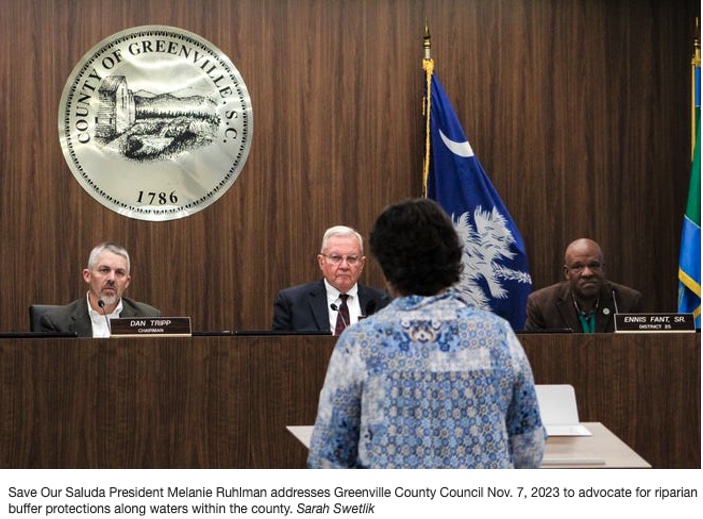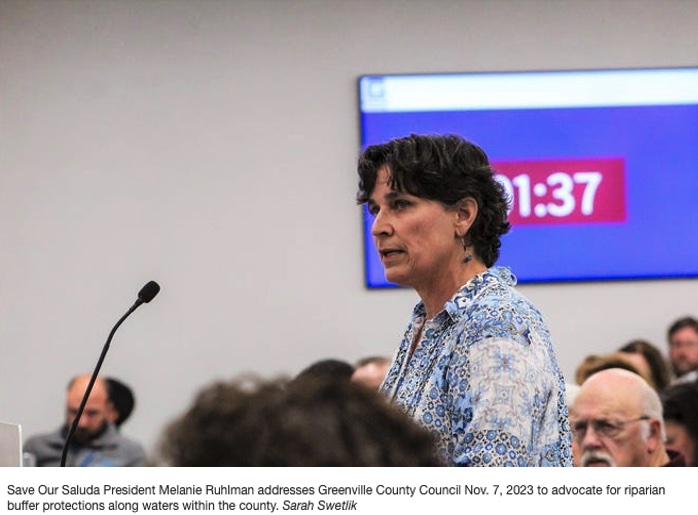Greenville County takes steps to protect natural resources amid development concerns
Greenville News

As Upstate communities continue to work to accommodate record growth, Greenville County Council on Tuesday voted favorably on a second reading of an ordinance that would require environmental protections and development limits in the county.
The ordinance will require a protected land area called a riparian buffer along streams and water bodies throughout the county. Greenville County’s riparian buffers will be a minimum of 50 feet from the edge of the water inland and will establish separation between water and the land nearby to protect both water quality and stream banks.
The ordinance also will restrict new subdivision developments in unzoned areas to meet a minimum lot size of one and a half acres to install a septic system.
The ordinance, which passed 9-3 with an amendment from Chairman Dan Tripp, is expected to receive a third and final reading Dec. 7. Councilman Ennis Fant said during Tuesday’s meeting that council members have been working on the ordinance for about nine months with extensive debate since its creation.
Various council members, members of environmental groups and developers suggested dividing the two topics from one ordinance. Most were in favor of riparian buffer protections, but others were divided on how to proceed with septic system regulations.
Residents in support of riparian buffers creation attended Tuesday’s meeting wearing blue and spoke in favor of the section of the ordinance.
Riparian buffers could protect water quality and stream banks
A riparian buffer is a strip of vegetation, like grasses, shrubs, trees or other plants, that protects a body of water from the impact of adjacent land use. If the ordinance passes the third reading, a minimum 50-foot buffer area will be required along Greenville County’s streams and jurisdictional waters, while a 100-foot buffer area will be required in areas with a higher volume of drainage.
The implementation of buffer protections in the Upstate is an effort multiple environmental groups, including Save Our Saluda, have worked on for years.
“Benefits of riparian buffers are many. They can help to filter sediment runoff and other pollutant runoff from getting into the river,” said Melanie Ruhlman, president of Save Our Saluda. “They, very importantly, hold land together and keep streambanks, riverbanks from eroding and falling away into the stream and to downstream reservoirs and drinking water sources.”
Ruhlman said she’s been working on riparian protections in Greenville since 2018, though efforts began before she was involved. The push for riparian buffers came from the Reedy River Water Quality Group, which is comprised of local, national and federal partners that work to improve the water quality of the Reedy River.
Establishing protective buffers is more cost-effective than trying to fix a damaged stream bank, Ruhlman said. Some projects require more than $100,000 to fix a small area of a stream, she said.
“The cost can range anywhere from $250 a linear foot per side up to $1,000 or more per linear foot,” she said.
Stream damage can lead to banks eroding and sediment falling into the water.
The Reedy River Water Quality Group’s push for buffers comes as part of a provision in the Clean Water Act. The Act allows local stakeholders to address pollutants in their water bodies rather than following a government-regulated plan to remove pollutants.
In addition to alleviating pressure on streambanks, buffers can also help filter excess nutrients like nitrate and phosphorus, pesticides and waste and prevent them from entering the waterway.

Limited septic systems could curb unchecked development
Under the ordinance, new developments built in unzoned areas of Greenville County with more than 10 lots served by a septic tank must have a minimum lot size of one and a half acres.
This portion of the ordinance was driven by the county, rather than environmental groups, and faced pushback from developers.
In a workshop on Oct. 2, Greenville County Department of Community Planning and Development Planning Director Rashida Jeffers-Campbell said the county is struggling to allocate land appropriately as the population continues to grow. She said the way the county currently distributes land makes it difficult to plan for transportation, sewers and schools.
“Current development trends are characterized by inefficient land consumption, and we all know that land is a finite resource,” Jeffers-Campbell said.
In efforts to combat additional pollution and slow development sprawl, Jeffers-Campbell said the ordinance aims to place limits on the use of septic systems in areas without current zoning laws. The ordinance will redirect developers toward areas where infrastructure already exists.
Jeffers-Campbell said the purpose of the ordinance is to limit the use of septic systems and limit high-density developments in areas where infrastructure can’t be easily expanded.
Despite requests from developers to make the minimum lot size smaller, Greenville County decided to move forward with the one-and-a-half-acre minimum lot size. In a planning meeting on Oct. 24, Jeffers-Campbell said making the minimum lot size any smaller would take away the incentive for developers to focus growth in areas with existing infrastructure.
How can a septic system impact the environment?
County officials voiced concern that many septic systems in high-density areas could impact development down the road, but septic systems that aren’t working properly can also pose environmental and health concerns.
Failing septic systems can expose residents to nutrients such as phosphorus and nitrogen. When they’re close to a water body, they can also contaminate surface water, according to the Environmental Protection Agency.
For most people, septic systems aren’t top of mind until they stop working, said Erika Hollis, clean water director at Upstate Forever.
While Upstate Forever was not involved in the septic portion of the ordinance, they work with the South Carolina Department of Health and Environmental Control to assist homeowners with fixing septic systems in Upstate counties. In a decade, Hollis said Upstate Forever’s grants have assisted more than 130 homeowners with septic tank repair.
In homes with septic systems, wastewater drains into an underground tank, where it is held as the water separates from solid matter, which sinks to the bottom, from oil and grease, which float to the top. The water then leaves the tank and travels to a section of soil called a drain field, according to the Environmental Protection Agency.
“Once it's not working, it's definitely like a crisis situation if you can't flush your toilet, you can't take a shower, you can't do your laundry or do your dishes,” Hollis said, adding that homeowners tend to call Upstate Forever once they’ve reached a backup. “It becomes a major quality of life issue if you can't live in a home with a functioning wastewater treatment system.”
Hollis said nine out of 10 repairs Upstate Forever handles are drain fields that aren’t working properly. Homeowners often don’t know where their drain field is, especially in older homes where septic tanks are already installed. Residents who don’t know where their drain field is located might build too close to it or park on top of it and damage it, Hollis said.
Improper use of the drain field can cause damage to the septic systems, but few records exist to help homeowners know where their drain fields are, nor are there any state laws that require inspections or dictate how often owners should get their septic tanks pumped. Fixing a damaged septic system can also be costly for the homeowner. Hollis said the average cost to fix a drainfield is currently $6,500.
Before any development or water protections can be put in place, the ordinance will have to pass a third reading. Council is set to meet next Dec. 7.
Sarah Swetlik covers climate change and environmental issues in South Carolina's Upstate for The Greenville News. Reach her at This email address is being protected from spambots. You need JavaScript enabled to view it. or on X at @sarahgswetlik.


